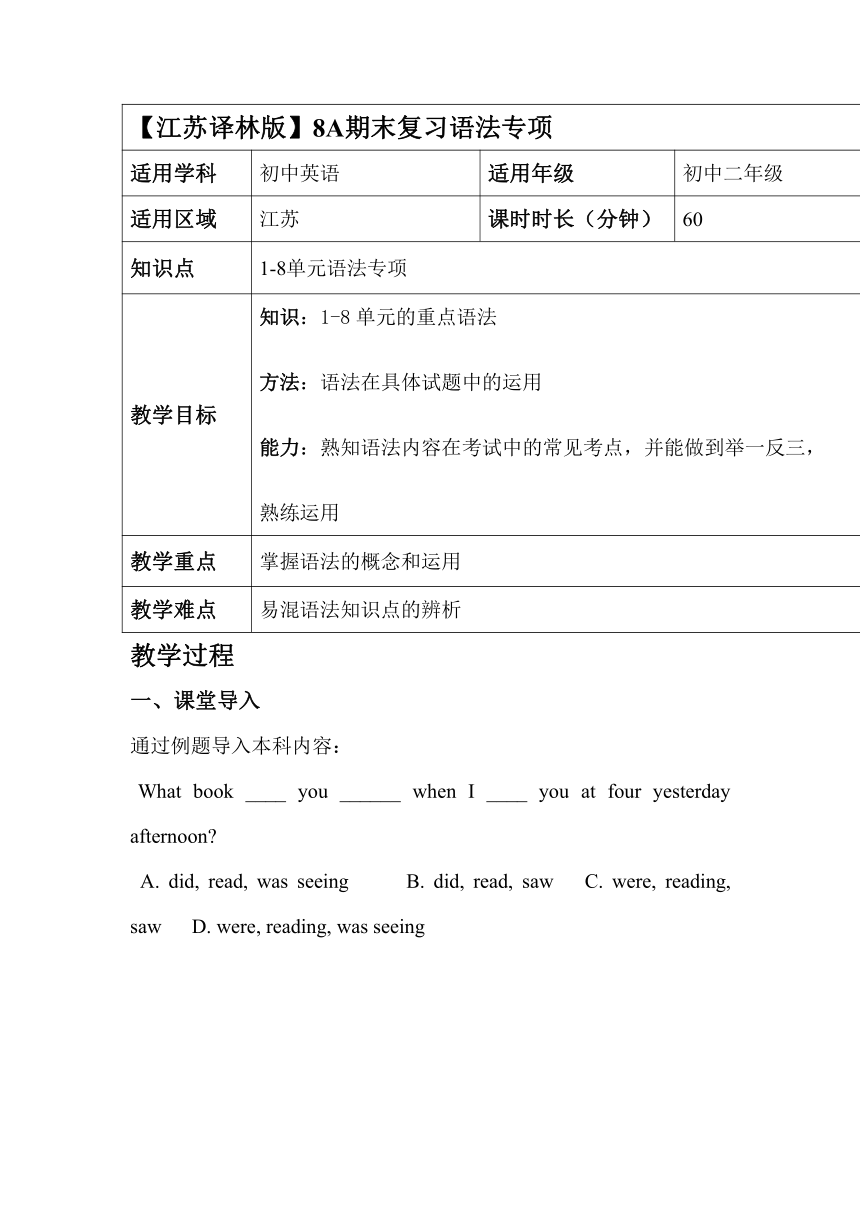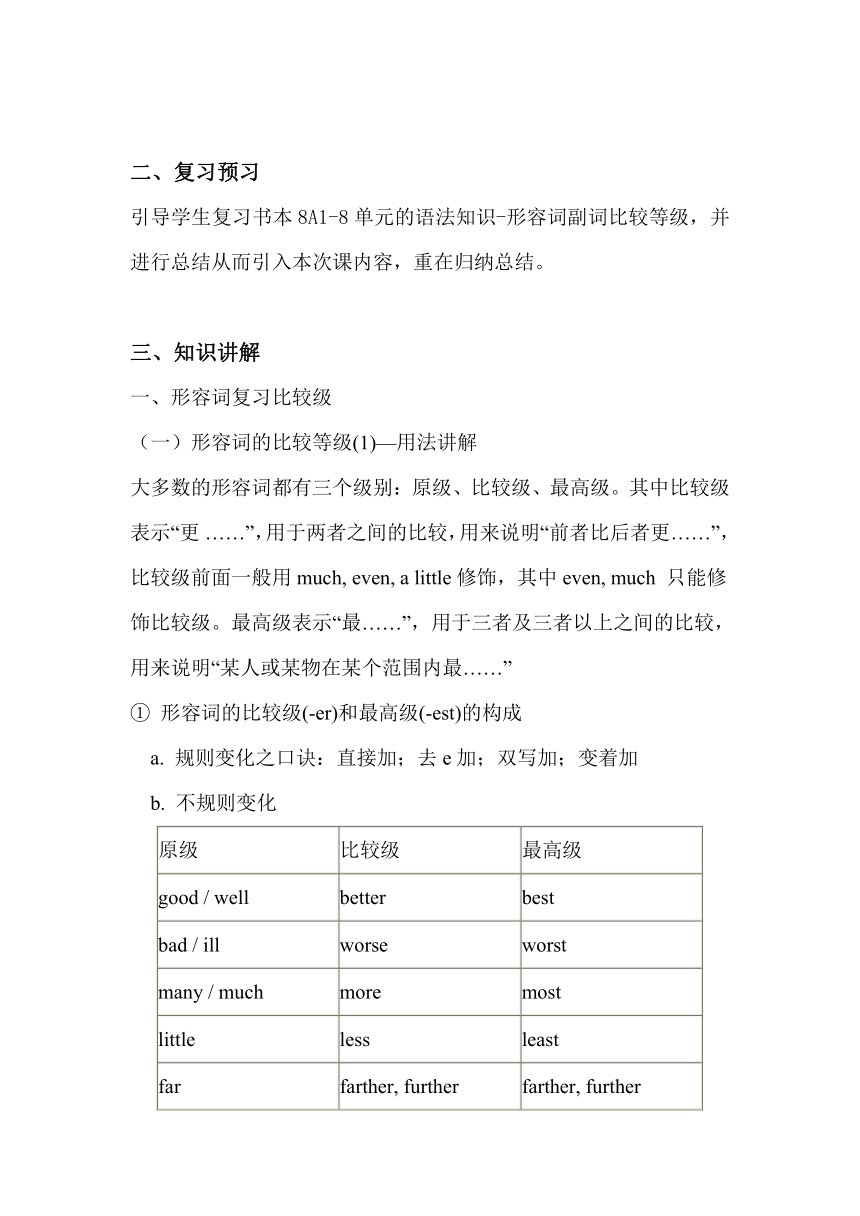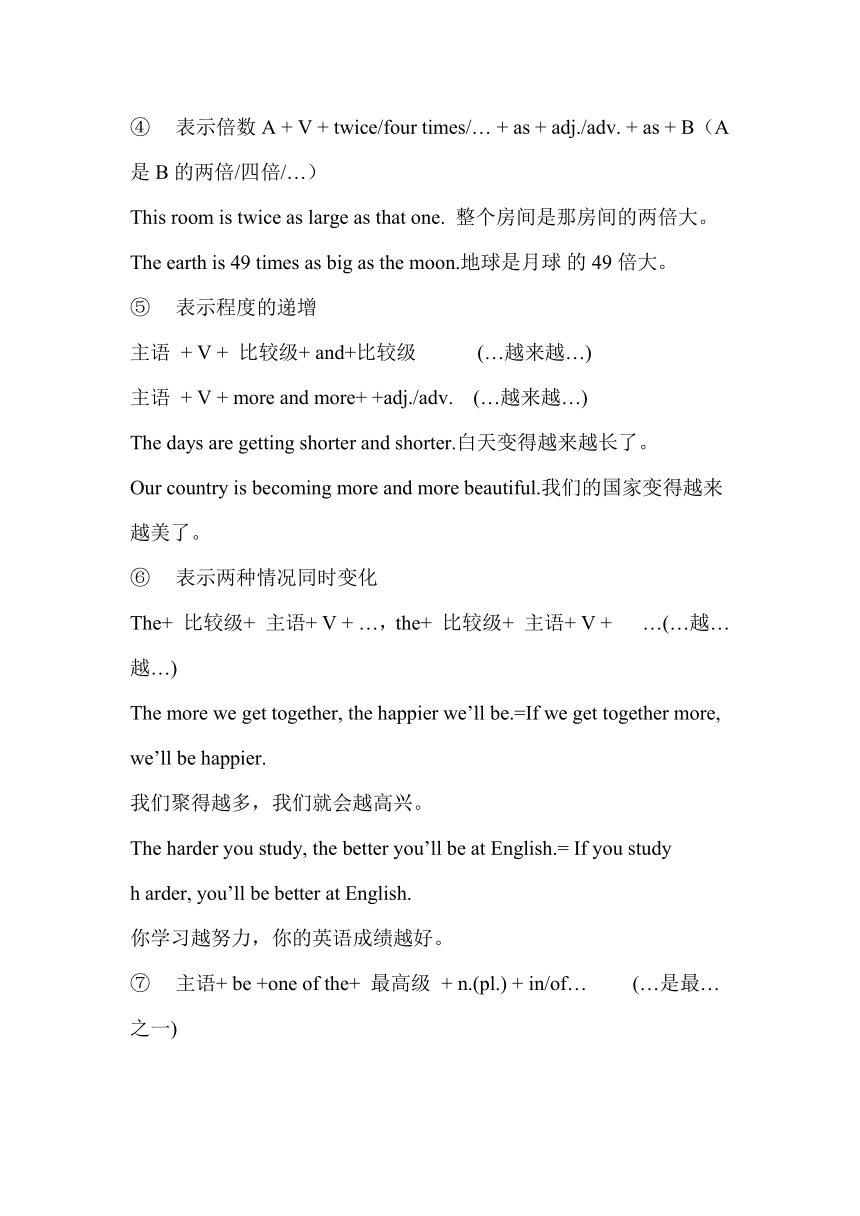天津学大教育信息咨询有限公司牛津译林版八年级英语上册复习教案:语法专项
文档属性
| 名称 | 天津学大教育信息咨询有限公司牛津译林版八年级英语上册复习教案:语法专项 |  | |
| 格式 | zip | ||
| 文件大小 | 29.7KB | ||
| 资源类型 | 教案 | ||
| 版本资源 | 牛津译林版 | ||
| 科目 | 英语 | ||
| 更新时间 | 2016-04-27 11:53:22 | ||
图片预览





文档简介
【江苏译林版】8A期末复习语法专项
适用学科 初中英语 适用年级 初中二年级
适用区域 江苏 课时时长(分钟) 60
知识点 1-8单元语法专项
教学目标 知识:1-8单元的重点语法方法:语法在具体试题中的运用能力:熟知语法内容在考试中的常见考点,并能做到举一反三,熟练运用
教学重点 掌握语法的概念和运用
教学难点 易混语法知识点的辨析
教学过程
一、课堂导入
通过例题导入本科内容:
What book ____ you ( http: / / www.21cnjy.com )______ when I ____ you at four yesterday afternoon
A. did, read, was seeing B. did, read, saw C. were, reading, saw D. were, reading, was seeing
二、复习预习
引导学生复习书本8A1-8单元的语法知识-形容词副词比较等级,并进行总结从而引入本次课内容,重在归纳总结。
三、知识讲解
一、形容词复习比较级
(一)形容词的比较等级(1)—用法讲解
大多数的形容词都有三个级别:原级、比较级、 ( http: / / www.21cnjy.com )最高级。其中比较级表示“更 ……”,用于两者之间的比较,用来说明“前者比后者更……”,比较级前面一般用much, even, a little修饰,其中even, much 只能修饰比较级。最高级表示“最……”,用于三者及三者以上之间的比较,用来说明“某人或某物在某个范围内最……”
① 形容词的比较级(-er)和最高级(-est)的构成
a. 规则变化之口诀:直接加;去e加;双写加;变着加
b. 不规则变化
原级 比较级 最高级
good / well better best
bad / ill worse worst
many / much more most
little less least
far farther, further farther, further
old older, elder oldest, eldest
② 形容词的比较级和最高级的构成及用法
③ 比较级前的修饰语
still, even, any, qui ( http: / / www.21cnjy.com )te(a bit), almost, nearly, just, rather;a little, a bit;much, a lot, far, many;twice, ten times, one fourth, two pounds, three years
(二)形 容词的比较等级(2)—常见句型
① A=B A+ V + as + adj./adv. + as + B (与。。。一样)
He is as tall as I/me. 他和我一样高。
He is as good a teacher as his father.他和他的父亲一样是个好教师。
② A≠ B A + V + not + as/so + adj./adv. + as + B (与。。。不一样)
They didn’t do as/so much work as you did. 他们干得事没有你多。
I’ve never seen as/so old a car as this.我从来没有见过像这样旧的车。
③ A > B 或A ( http: / / www.21cnjy.com ) < B A + V + 比较级 + than + B (比。。。<更>。。。)
Tom is two years older than his brother. 汤姆比他的弟弟大两岁。
Our classroom is bigger than theirs. 我们的教室比他们的大。
④ 表示倍数A + V + twice/four times/… + as + adj./adv. + as + B(A是B的两倍/四倍/…)
This room is twice as large as that one. 整个房间是那房间的两倍大。
The earth is 49 times as big as the moon.地球是月球 的49倍大。
⑤ 表示程度的递增
主语 + V + 比较级+ and+比较级 (…越来越…)
主语 + V + more and more+ +adj./adv. (…越来越…)
The days are getting shorter and shorter.白天变得越来越长了。
Our country is becoming more and more beautiful.我们的国家变得越来越美了。
⑥ 表示两种情况同时变化
The+ 比较级+ 主语+ V + …,the+ 比较级+ 主语+ V + …(…越…越…)
The more we get together, the happier we’ll be.=If we get together more, we’ll be happier.
我们聚得越多,我们就会越高兴。
The harder you st ( http: / / www.21cnjy.com )udy, the better you’ll be at English.= If you study h arder, you’ll be better at English.
你学习越努力,你的英语成绩越好。
⑦ 主语+ be +one of the+ 最高级 + n.(pl.) + in/of… (…是最…之一)
Beijing is one of the oldest cities in China.北京是中国最古老的城市之一。
⑧ 主语+ V.+ the+ 最高级 + in/of… (…最…)
Ann studies hardest of all the girls in our class.安妮是我们班学习最用功的学生之一。
⑨ 主语+ V.+ the+ 比较级 + of the two… (…<两者中>较…的)
Lily is the taller of the twins.莉莉是这两个双胞胎中较高的那个。
⑩ 主语+ V.+ 比较级 + than + any other +n. (单数) + in… (…比任何其他的更…)
主语+ V.+ 比较级 + than + any of the other +n. (复数) + in…(…比任何其他的更…)
He is taller than any other student i n his class.他比他班级中其他的任何学生高。
= He is taller than any of the other students in his class.
= He is the tallest students in his class.
总结:
1.英语中某些副词短语的意义和用法很重要。 这类短语常见的还有: more than, no more than, too much, much too, by far, more than, more… than, no less than, not less than 等,在平常练习中要加以注意。
2.意义相近的形容词和副词的用法要加以注意: hard, hardly; deep, deeply; high, highly; dead,deadly; most, mostly; fair, fairly; quite, fairly, rather; almost, nearly; such 等。
3.多个形容词同时一个名词时,多用下列顺序:性质+大小+形状+新旧+颜色,有时也要看与名词的密切关系,越密切越靠近名词。多个词同时作前置定语时的一般排列规律是:代词性定语+冠词/指/物主/所有格+数词(先序后基)+形容词+国籍/材料/用途形容词或名词或动名词+被修饰的名词。例如:a charming small round old brown French oak writing table.
二、反身代词
(一)反身代词用法讲解
1、反身代词的构成
反身代词又称自身代词,有人称和数的 ( http: / / www.21cnjy.com )变化。其中,第一、二人称的反身代词由“形容词性物主代词 + 后缀-self(单数)/ - selves(复数)”构成,第三人称的反身代词由“人称代词的宾格 + 后缀-self(单数)/ - selves(复数)”构成。
人称 第一人称 第二人称 第三人称
单数 myself yourself himself herself itself
复数 ourselves yourselves themselves
2、反身代词的用法
① She called herself Xiao Zhang. 她自称小张。
② We can look after ourselves well. 我们会照顾好自己的。
③ The poor boy in the story is myself. 故事里的那个可怜的男孩就是我自己
④ They finished the work themselves. 他们独自完成了工作。
⑤ Did you see Mr. Wang himself 你见过 王先生本人吗?
【规律总结】
反身代词可以作动词或介词的宾语,如例句①②;可以作表语,如例句③;可以作主语或宾语的同位语,用于加强语气,意为“亲自,本人”,如例句④⑤。
★一些常用的固定搭配
look after oneself / take care of oneself 照顾自己
teach oneself sth. / learn sth. by oneself 自学
enjoy oneself 玩得高兴,过得愉快
help oneself to sth. 请自用……(随便吃/喝些……)
hurt oneself摔伤自己
say to oneself 自言自语
(二)易错点讲解
① 反身代词不能单独做主语,但可以做主语的同位语,起强调作用。例如:
我自己能完成作业。(误)Myself can finish my homework.
(正)I myself can finish my homework.
② 反身代词表示“某人自己”,不能表示“某人 ( http: / / www.21cnjy.com )自己的东西”,因为它没有所有格的形式。表达“某人自己的(东西)”时,须要用one’s own. 例如:
我用我自己的蜡笔画画。(误)I’m drawing with myself crayons.
(正)I’m drawing with my own crayons.
三、祈使句
(一)祈使句用法讲解
祈使句指的是表示命令、请求、建议或劝告的句子。其主语you常省略,谓语动词用原形,句末用感叹号或句号,读降调。
1. 肯定的祈使句
(1)动词原形+其他
Stand up, please. = Please stand up. 请起立。
(2)Be + n./adj.
Be a go ( http: / / www.21cnjy.com )od boy! 要做一个好孩子! Be careful! = Look out! = Take care! 小心 / 当心!
(3)Let + 宾语 + 动词原形 + 其它成分
Let me help yo ( http: / / www.21cnjy.com )u. 让我来帮你。 Let’s go to school together. 咱们一起上学去吧。
2. 否定的祈使句
(1) Don't + 动词原形
Don't stand up. 别站起来。
Don't be careless. 别粗心。
Don't let them play with fire. 别让他们玩火。
(2) Let型的否定式有两种:“Don't + let + 宾语 + 动词原形 + 其它成分”和“Let + 宾语
+ not + 动词原形 + 其它成分”。
Don't let him go. / Let him not go. 别让他走。
Let them not play with fire. 别让他们玩火。
(3) no开头,用来表示禁止性的祈使句。
No smoking! 禁止吸烟!No fishing! 禁止钓鱼!
3. 祈使句的强调形式,通常在肯定祈使句式前加上助动词Do。
例如:Do shut up! 快住口!
4. 祈使句的回答 祈使句的动作通常是表示将来发生的动作,所以回答祈使句时,一般用
will或won’t。
在回答具有否定意义的祈使句时,要注意两点:
1) 形式一致(即Yes与will保持一致;No与won’t保持一致)
2) 意思相反(即Yes是 “不”的意思;No是 “是”的意思)。
在回答时,要注意分析上下文语境中所提供的条件。
如:--- Don’t go out, ( http: / / www.21cnjy.com ) please. It’s raining heavily outside. 请不要出去。外面雨下得很大。
---- Yes, I wi ( http: / / www.21cnjy.com )ll. I have to meet my brother at the airport. 不行,我得去机场接我弟弟。
(二)易错点讲解
1、放句首时,要注意Don’t后面要用动词原形;
2、当人称后面有标点符号时,要注意是用祈使句还是用三单。
如:Lucy, don’t be late again.
Lucy, a 17-year-old girl, is not late again.
3、祈使句与or的搭配, 如:Hands up, or we’ll shoot.
四、should和had better
(一)should用法讲解
1. 用于第 ( http: / / www.21cnjy.com )一人称疑问句,表征询意见。如:Should I open the window 我可以开窗户吗?
2. should表义务,可用于各种句式,通常指将来。
如:You should do wh ( http: / / www.21cnjy.com )at your parents tell you. 你应该照你父母的话去做事。
He should do some work, but he doesn’t want to.他应该做些工作,但是他不想做。
也可指现在。如:
You shouldn’t be sitting in the sun. 你不应该坐在阳光下。
3. should表推测,暗含很大的可能。如:
It’s 4:30. They should be in New York by now. 现在是四点半,他们应该到达纽约了。
(二)had better用法讲解
1. had better的基本用法特点
其意为“最好”、“应该”,后接动词原形,与情态动词should用法相似,其中的had通常缩略为 ‘d。如:
You’d better get some sleep.你最好去睡一会儿。
We had better go before it rains. 我们最好在下雨前就去。
2. had better如何构成否定式和疑问式
构成否定式时,通常将not置于had ( http: / / www.21cnjy.com )better之后(而不是had之后);而构成疑问式时,则通常将had(而不是had better)置于主语之前。如:
I’d better not disturb him.我最好别去打扰他。
What had we better do 我们最好怎么办
【注】在否定疑问句或反意疑问句中可将not与had连用。如:
Hadn’t we better go now 我们是不是现在就去呢
3. had better后接进行式
有时后接动词的进行式,表示最好马上做某事如:
I think I’d better be going.我想我最好还是马上走。
You’d better be getting your clothes ready. 你最好马上把衣服准备好。
五、may的用法
1. 表推测,意为“可能,也许”,用于肯定句中。
He may come tomorrow. 他明天可能会来。
2.表请求、许可,意为“可以”。
例:May I borrow your book 我可以借用你的书么?
注意:may表请求,用于主语为第一人称的一般疑问句时,
其否定回答用mustn’t或can’t, 不用may not, 意为“不可以,不允许,禁止”。
例:--May I go now 我现在可以走了么?
--No, you mustn’t. 不,不可以。
3. can 和may均可用来表示征求意见或允许,意为“可以”,一般可互换使用。
may 的基本用法就是表示请求 ( http: / / www.21cnjy.com )时的“可以”和猜测时的“可能”,但要再次强调may 表示猜测时是可以用在肯定句、否定句中的。另外,may引起的一般疑问句,其回答需要注意:肯定回答可以使用may或者can都可以,但否定回答则不能用may not, 只能用can’t 或者mustn’t.
六、动词不定式的用法
1、动词不定式作宾语
一些动词,如want, decide, ( http: / / www.21cnjy.com ) hope, ask, agree, choose, learn, plan, need, teach, prepare,等,常接动词不定式作宾语。当动词不定式作宾语时,如果后接宾语补足语,常用it作形式宾语,而把真正的宾语放在宾语补足语之后。应注意有些动词后面可接不定式作宾语,也可接动名词作宾语,但所表达的意义不同。
常见的有:
(1)stop to do sth.停止正在做的事,去做另一件事;stop doing sth. .停止正在做的事
(2)go on to do sth. 做完一件事后,继续做另一件事;go on doing sth.继续做同一件事
(3)remember/forget to ( http: / / www.21cnjy.com ) do sth.记住/忘记去做某事;remember/forget doing sth. 记得/忘记做过某事
有一些动词后面后面是省略to的情况,如see, watch, look at, hear, make, let, help等。
常考词组:expect to ( http: / / www.21cnjy.com ) do 期望做。 refuse to do 拒绝做。 plan to do计划做。 decide to do 决定做。
agree to do 同意做。 ( http: / / www.21cnjy.com )learn to do 学会做。 hope to do 希望做。 prepare to do 准备做。
want to do 想做。 choose to do 选择做。 wait to do 等待做。wish to do 希望做。
2、动词不定式作状语
动词不定式作状语主要用来修饰动词,表示 ( http: / / www.21cnjy.com )目的,结果或原因。为了强调目的,有时可以把动词不定式放在句首,或在不定式前加in order或so as。常用结构有too + adj./adv. + to dosth.等。
七、句子结构
简单句的五个基本句型
主语 + 不及物动词 She came./ My head aches.
主语 + 及物动词 +宾语 She likes English.
主语 + 系动词 +主语补语 She is happy.
主语 + 双宾动词 +间接宾语 +直接宾语 She gave John a book.
She bought a book for me.
主语 + 宾补动词 + 宾语 + 宾语补语She makes her mother angry.
八、过去进行时
(一)定义
过去进行时,是表示过去某个具体时刻正在进行的事情或动作。
(二)结构
was/were +doing (现在分词)
(三)用法
1、过去进行时表示过去某段时间内持续进行的动作或者事情。常用的时间状语this morning, the whole morning, all day yesterday, from nine to ten last evening, when, while例如:
(1)We were watching TV from seven to nine last night.
昨天晚上七点到九点的时候我们在看电视。
(2)What was he researching all day last Sunday 上周日他一整天都在研究什么?
2. 过去进行时可以表示在过去某个时间点 ( http: / / www.21cnjy.com )发生的事情。时间点可以用介词短语、副词或从句来表示。如: What was she doing at nine o'clock yesterday
昨天晚上九点她在做什么? (介词短语表示时间点)
When I saw him he was decorating his room.
当我看见他的时候他正在装饰房间。 (when从句表示时间点)
3. 在复合句中,如果主要动作和背景动作都 ( http: / / www.21cnjy.com )是延续的或同时发生的,那么主从句的动词都可用过去进行时。例如:
While he was waiting for the bus, he was reading a newspaper.
他边等车边看报。 (两个动作都是延续的)
He was cleaning his car while I was cooking.
他擦车时我在做饭。(两个动作同时进行)
4、表示在过去即将发生的动作。如:
She asked him whether he was coming back for supper.
5、表示过去的反复性或习惯性的动作, ( http: / / www.21cnjy.com )常与副词always,constantly,continually,frequently等连用,常常带有说话人的某种感彩。如:
His mother was always working like that.他目前总是那样工作。
6. 通常不能用于过去进行时的动词主 ( http: / / www.21cnjy.com )要有:agree, be, believe, belong, care, forget, hate, have(拥有), hear, know, like, love, mean, mind, notice, own, remember, seem, suppose, understand, want, wish等。
(四)过去进行时与一般过去时的区别
(1)过去进行时与一般过去时,两者都表示 ( http: / / www.21cnjy.com )过去发生的动作,但过去进行时表示在过去某一特定的时间点或时间段正在进行的动作,而一般过去时表示在过去时间完成的动作 例如:
I was typing a letter last night. 昨晚我在打一封信 (可能没打完)
I typed some letters last night. 我昨晚打了一些信 (已经打完)
A. 过去进行时却表示动作在持续或未完成,而一般过时往往表示某一动作已经完成。
I was reading the book at that time. (未读完,“读”的片段)
I read the book yesterday. (已读完,表整个“读”)
B、一般过去时表示只做一次动作,而过去进行时却表示动作反复地进行。
She waved to me. 她朝我挥了挥手。
It was raining all night.(优先用was raining ,rained 为持续动词,故也可使用)
He was writing a letter the whole of afternoon.
(短暂动词与持续时间连用,表反复,连续发生,不可用一般过去时)
四、例题精析
【例题1】
【题干】This __ girls are Linda’s cousin.
A. pretty little Spanish B. Spanish little pretty
C. Spanish pretty little D. little pretty Spanish
【答案】A
【解析】 本题考查考生多个形容词作定语时的位置关系。
【例题2】
【题干】David has won ( http: / / www.21cnjy.com ) the first prize in singing; he is still very excited now and feels __ desire to go to bed.
A. the most B. more C. worse D. the least
【答案】D
【解析】解答本题首先要理解语境。David刚刚获奖,还很兴奋,那么睡觉的欲望当然是很少了。the least表示“最少的”的意思。
【例题3】
【题干】It was interest ( http: / / www.21cnjy.com )ing _______(see) so many places of interest from all over the world.
【答案】to see
【解析】考查动词不定式做主语。本句中it为形式主语,动词不定式做主语。
课程小结
本课主要复习总结了8A 1-8单元的重点语法点。难点为对语法的灵活使用,要求学生结合练习加以理解并记住常用的搭配。
适用学科 初中英语 适用年级 初中二年级
适用区域 江苏 课时时长(分钟) 60
知识点 1-8单元语法专项
教学目标 知识:1-8单元的重点语法方法:语法在具体试题中的运用能力:熟知语法内容在考试中的常见考点,并能做到举一反三,熟练运用
教学重点 掌握语法的概念和运用
教学难点 易混语法知识点的辨析
教学过程
一、课堂导入
通过例题导入本科内容:
What book ____ you ( http: / / www.21cnjy.com )______ when I ____ you at four yesterday afternoon
A. did, read, was seeing B. did, read, saw C. were, reading, saw D. were, reading, was seeing
二、复习预习
引导学生复习书本8A1-8单元的语法知识-形容词副词比较等级,并进行总结从而引入本次课内容,重在归纳总结。
三、知识讲解
一、形容词复习比较级
(一)形容词的比较等级(1)—用法讲解
大多数的形容词都有三个级别:原级、比较级、 ( http: / / www.21cnjy.com )最高级。其中比较级表示“更 ……”,用于两者之间的比较,用来说明“前者比后者更……”,比较级前面一般用much, even, a little修饰,其中even, much 只能修饰比较级。最高级表示“最……”,用于三者及三者以上之间的比较,用来说明“某人或某物在某个范围内最……”
① 形容词的比较级(-er)和最高级(-est)的构成
a. 规则变化之口诀:直接加;去e加;双写加;变着加
b. 不规则变化
原级 比较级 最高级
good / well better best
bad / ill worse worst
many / much more most
little less least
far farther, further farther, further
old older, elder oldest, eldest
② 形容词的比较级和最高级的构成及用法
③ 比较级前的修饰语
still, even, any, qui ( http: / / www.21cnjy.com )te(a bit), almost, nearly, just, rather;a little, a bit;much, a lot, far, many;twice, ten times, one fourth, two pounds, three years
(二)形 容词的比较等级(2)—常见句型
① A=B A+ V + as + adj./adv. + as + B (与。。。一样)
He is as tall as I/me. 他和我一样高。
He is as good a teacher as his father.他和他的父亲一样是个好教师。
② A≠ B A + V + not + as/so + adj./adv. + as + B (与。。。不一样)
They didn’t do as/so much work as you did. 他们干得事没有你多。
I’ve never seen as/so old a car as this.我从来没有见过像这样旧的车。
③ A > B 或A ( http: / / www.21cnjy.com ) < B A + V + 比较级 + than + B (比。。。<更>。。。)
Tom is two years older than his brother. 汤姆比他的弟弟大两岁。
Our classroom is bigger than theirs. 我们的教室比他们的大。
④ 表示倍数A + V + twice/four times/… + as + adj./adv. + as + B(A是B的两倍/四倍/…)
This room is twice as large as that one. 整个房间是那房间的两倍大。
The earth is 49 times as big as the moon.地球是月球 的49倍大。
⑤ 表示程度的递增
主语 + V + 比较级+ and+比较级 (…越来越…)
主语 + V + more and more+ +adj./adv. (…越来越…)
The days are getting shorter and shorter.白天变得越来越长了。
Our country is becoming more and more beautiful.我们的国家变得越来越美了。
⑥ 表示两种情况同时变化
The+ 比较级+ 主语+ V + …,the+ 比较级+ 主语+ V + …(…越…越…)
The more we get together, the happier we’ll be.=If we get together more, we’ll be happier.
我们聚得越多,我们就会越高兴。
The harder you st ( http: / / www.21cnjy.com )udy, the better you’ll be at English.= If you study h arder, you’ll be better at English.
你学习越努力,你的英语成绩越好。
⑦ 主语+ be +one of the+ 最高级 + n.(pl.) + in/of… (…是最…之一)
Beijing is one of the oldest cities in China.北京是中国最古老的城市之一。
⑧ 主语+ V.+ the+ 最高级 + in/of… (…最…)
Ann studies hardest of all the girls in our class.安妮是我们班学习最用功的学生之一。
⑨ 主语+ V.+ the+ 比较级 + of the two… (…<两者中>较…的)
Lily is the taller of the twins.莉莉是这两个双胞胎中较高的那个。
⑩ 主语+ V.+ 比较级 + than + any other +n. (单数) + in… (…比任何其他的更…)
主语+ V.+ 比较级 + than + any of the other +n. (复数) + in…(…比任何其他的更…)
He is taller than any other student i n his class.他比他班级中其他的任何学生高。
= He is taller than any of the other students in his class.
= He is the tallest students in his class.
总结:
1.英语中某些副词短语的意义和用法很重要。 这类短语常见的还有: more than, no more than, too much, much too, by far, more than, more… than, no less than, not less than 等,在平常练习中要加以注意。
2.意义相近的形容词和副词的用法要加以注意: hard, hardly; deep, deeply; high, highly; dead,deadly; most, mostly; fair, fairly; quite, fairly, rather; almost, nearly; such 等。
3.多个形容词同时一个名词时,多用下列顺序:性质+大小+形状+新旧+颜色,有时也要看与名词的密切关系,越密切越靠近名词。多个词同时作前置定语时的一般排列规律是:代词性定语+冠词/指/物主/所有格+数词(先序后基)+形容词+国籍/材料/用途形容词或名词或动名词+被修饰的名词。例如:a charming small round old brown French oak writing table.
二、反身代词
(一)反身代词用法讲解
1、反身代词的构成
反身代词又称自身代词,有人称和数的 ( http: / / www.21cnjy.com )变化。其中,第一、二人称的反身代词由“形容词性物主代词 + 后缀-self(单数)/ - selves(复数)”构成,第三人称的反身代词由“人称代词的宾格 + 后缀-self(单数)/ - selves(复数)”构成。
人称 第一人称 第二人称 第三人称
单数 myself yourself himself herself itself
复数 ourselves yourselves themselves
2、反身代词的用法
① She called herself Xiao Zhang. 她自称小张。
② We can look after ourselves well. 我们会照顾好自己的。
③ The poor boy in the story is myself. 故事里的那个可怜的男孩就是我自己
④ They finished the work themselves. 他们独自完成了工作。
⑤ Did you see Mr. Wang himself 你见过 王先生本人吗?
【规律总结】
反身代词可以作动词或介词的宾语,如例句①②;可以作表语,如例句③;可以作主语或宾语的同位语,用于加强语气,意为“亲自,本人”,如例句④⑤。
★一些常用的固定搭配
look after oneself / take care of oneself 照顾自己
teach oneself sth. / learn sth. by oneself 自学
enjoy oneself 玩得高兴,过得愉快
help oneself to sth. 请自用……(随便吃/喝些……)
hurt oneself摔伤自己
say to oneself 自言自语
(二)易错点讲解
① 反身代词不能单独做主语,但可以做主语的同位语,起强调作用。例如:
我自己能完成作业。(误)Myself can finish my homework.
(正)I myself can finish my homework.
② 反身代词表示“某人自己”,不能表示“某人 ( http: / / www.21cnjy.com )自己的东西”,因为它没有所有格的形式。表达“某人自己的(东西)”时,须要用one’s own. 例如:
我用我自己的蜡笔画画。(误)I’m drawing with myself crayons.
(正)I’m drawing with my own crayons.
三、祈使句
(一)祈使句用法讲解
祈使句指的是表示命令、请求、建议或劝告的句子。其主语you常省略,谓语动词用原形,句末用感叹号或句号,读降调。
1. 肯定的祈使句
(1)动词原形+其他
Stand up, please. = Please stand up. 请起立。
(2)Be + n./adj.
Be a go ( http: / / www.21cnjy.com )od boy! 要做一个好孩子! Be careful! = Look out! = Take care! 小心 / 当心!
(3)Let + 宾语 + 动词原形 + 其它成分
Let me help yo ( http: / / www.21cnjy.com )u. 让我来帮你。 Let’s go to school together. 咱们一起上学去吧。
2. 否定的祈使句
(1) Don't + 动词原形
Don't stand up. 别站起来。
Don't be careless. 别粗心。
Don't let them play with fire. 别让他们玩火。
(2) Let型的否定式有两种:“Don't + let + 宾语 + 动词原形 + 其它成分”和“Let + 宾语
+ not + 动词原形 + 其它成分”。
Don't let him go. / Let him not go. 别让他走。
Let them not play with fire. 别让他们玩火。
(3) no开头,用来表示禁止性的祈使句。
No smoking! 禁止吸烟!No fishing! 禁止钓鱼!
3. 祈使句的强调形式,通常在肯定祈使句式前加上助动词Do。
例如:Do shut up! 快住口!
4. 祈使句的回答 祈使句的动作通常是表示将来发生的动作,所以回答祈使句时,一般用
will或won’t。
在回答具有否定意义的祈使句时,要注意两点:
1) 形式一致(即Yes与will保持一致;No与won’t保持一致)
2) 意思相反(即Yes是 “不”的意思;No是 “是”的意思)。
在回答时,要注意分析上下文语境中所提供的条件。
如:--- Don’t go out, ( http: / / www.21cnjy.com ) please. It’s raining heavily outside. 请不要出去。外面雨下得很大。
---- Yes, I wi ( http: / / www.21cnjy.com )ll. I have to meet my brother at the airport. 不行,我得去机场接我弟弟。
(二)易错点讲解
1、放句首时,要注意Don’t后面要用动词原形;
2、当人称后面有标点符号时,要注意是用祈使句还是用三单。
如:Lucy, don’t be late again.
Lucy, a 17-year-old girl, is not late again.
3、祈使句与or的搭配, 如:Hands up, or we’ll shoot.
四、should和had better
(一)should用法讲解
1. 用于第 ( http: / / www.21cnjy.com )一人称疑问句,表征询意见。如:Should I open the window 我可以开窗户吗?
2. should表义务,可用于各种句式,通常指将来。
如:You should do wh ( http: / / www.21cnjy.com )at your parents tell you. 你应该照你父母的话去做事。
He should do some work, but he doesn’t want to.他应该做些工作,但是他不想做。
也可指现在。如:
You shouldn’t be sitting in the sun. 你不应该坐在阳光下。
3. should表推测,暗含很大的可能。如:
It’s 4:30. They should be in New York by now. 现在是四点半,他们应该到达纽约了。
(二)had better用法讲解
1. had better的基本用法特点
其意为“最好”、“应该”,后接动词原形,与情态动词should用法相似,其中的had通常缩略为 ‘d。如:
You’d better get some sleep.你最好去睡一会儿。
We had better go before it rains. 我们最好在下雨前就去。
2. had better如何构成否定式和疑问式
构成否定式时,通常将not置于had ( http: / / www.21cnjy.com )better之后(而不是had之后);而构成疑问式时,则通常将had(而不是had better)置于主语之前。如:
I’d better not disturb him.我最好别去打扰他。
What had we better do 我们最好怎么办
【注】在否定疑问句或反意疑问句中可将not与had连用。如:
Hadn’t we better go now 我们是不是现在就去呢
3. had better后接进行式
有时后接动词的进行式,表示最好马上做某事如:
I think I’d better be going.我想我最好还是马上走。
You’d better be getting your clothes ready. 你最好马上把衣服准备好。
五、may的用法
1. 表推测,意为“可能,也许”,用于肯定句中。
He may come tomorrow. 他明天可能会来。
2.表请求、许可,意为“可以”。
例:May I borrow your book 我可以借用你的书么?
注意:may表请求,用于主语为第一人称的一般疑问句时,
其否定回答用mustn’t或can’t, 不用may not, 意为“不可以,不允许,禁止”。
例:--May I go now 我现在可以走了么?
--No, you mustn’t. 不,不可以。
3. can 和may均可用来表示征求意见或允许,意为“可以”,一般可互换使用。
may 的基本用法就是表示请求 ( http: / / www.21cnjy.com )时的“可以”和猜测时的“可能”,但要再次强调may 表示猜测时是可以用在肯定句、否定句中的。另外,may引起的一般疑问句,其回答需要注意:肯定回答可以使用may或者can都可以,但否定回答则不能用may not, 只能用can’t 或者mustn’t.
六、动词不定式的用法
1、动词不定式作宾语
一些动词,如want, decide, ( http: / / www.21cnjy.com ) hope, ask, agree, choose, learn, plan, need, teach, prepare,等,常接动词不定式作宾语。当动词不定式作宾语时,如果后接宾语补足语,常用it作形式宾语,而把真正的宾语放在宾语补足语之后。应注意有些动词后面可接不定式作宾语,也可接动名词作宾语,但所表达的意义不同。
常见的有:
(1)stop to do sth.停止正在做的事,去做另一件事;stop doing sth. .停止正在做的事
(2)go on to do sth. 做完一件事后,继续做另一件事;go on doing sth.继续做同一件事
(3)remember/forget to ( http: / / www.21cnjy.com ) do sth.记住/忘记去做某事;remember/forget doing sth. 记得/忘记做过某事
有一些动词后面后面是省略to的情况,如see, watch, look at, hear, make, let, help等。
常考词组:expect to ( http: / / www.21cnjy.com ) do 期望做。 refuse to do 拒绝做。 plan to do计划做。 decide to do 决定做。
agree to do 同意做。 ( http: / / www.21cnjy.com )learn to do 学会做。 hope to do 希望做。 prepare to do 准备做。
want to do 想做。 choose to do 选择做。 wait to do 等待做。wish to do 希望做。
2、动词不定式作状语
动词不定式作状语主要用来修饰动词,表示 ( http: / / www.21cnjy.com )目的,结果或原因。为了强调目的,有时可以把动词不定式放在句首,或在不定式前加in order或so as。常用结构有too + adj./adv. + to dosth.等。
七、句子结构
简单句的五个基本句型
主语 + 不及物动词 She came./ My head aches.
主语 + 及物动词 +宾语 She likes English.
主语 + 系动词 +主语补语 She is happy.
主语 + 双宾动词 +间接宾语 +直接宾语 She gave John a book.
She bought a book for me.
主语 + 宾补动词 + 宾语 + 宾语补语She makes her mother angry.
八、过去进行时
(一)定义
过去进行时,是表示过去某个具体时刻正在进行的事情或动作。
(二)结构
was/were +doing (现在分词)
(三)用法
1、过去进行时表示过去某段时间内持续进行的动作或者事情。常用的时间状语this morning, the whole morning, all day yesterday, from nine to ten last evening, when, while例如:
(1)We were watching TV from seven to nine last night.
昨天晚上七点到九点的时候我们在看电视。
(2)What was he researching all day last Sunday 上周日他一整天都在研究什么?
2. 过去进行时可以表示在过去某个时间点 ( http: / / www.21cnjy.com )发生的事情。时间点可以用介词短语、副词或从句来表示。如: What was she doing at nine o'clock yesterday
昨天晚上九点她在做什么? (介词短语表示时间点)
When I saw him he was decorating his room.
当我看见他的时候他正在装饰房间。 (when从句表示时间点)
3. 在复合句中,如果主要动作和背景动作都 ( http: / / www.21cnjy.com )是延续的或同时发生的,那么主从句的动词都可用过去进行时。例如:
While he was waiting for the bus, he was reading a newspaper.
他边等车边看报。 (两个动作都是延续的)
He was cleaning his car while I was cooking.
他擦车时我在做饭。(两个动作同时进行)
4、表示在过去即将发生的动作。如:
She asked him whether he was coming back for supper.
5、表示过去的反复性或习惯性的动作, ( http: / / www.21cnjy.com )常与副词always,constantly,continually,frequently等连用,常常带有说话人的某种感彩。如:
His mother was always working like that.他目前总是那样工作。
6. 通常不能用于过去进行时的动词主 ( http: / / www.21cnjy.com )要有:agree, be, believe, belong, care, forget, hate, have(拥有), hear, know, like, love, mean, mind, notice, own, remember, seem, suppose, understand, want, wish等。
(四)过去进行时与一般过去时的区别
(1)过去进行时与一般过去时,两者都表示 ( http: / / www.21cnjy.com )过去发生的动作,但过去进行时表示在过去某一特定的时间点或时间段正在进行的动作,而一般过去时表示在过去时间完成的动作 例如:
I was typing a letter last night. 昨晚我在打一封信 (可能没打完)
I typed some letters last night. 我昨晚打了一些信 (已经打完)
A. 过去进行时却表示动作在持续或未完成,而一般过时往往表示某一动作已经完成。
I was reading the book at that time. (未读完,“读”的片段)
I read the book yesterday. (已读完,表整个“读”)
B、一般过去时表示只做一次动作,而过去进行时却表示动作反复地进行。
She waved to me. 她朝我挥了挥手。
It was raining all night.(优先用was raining ,rained 为持续动词,故也可使用)
He was writing a letter the whole of afternoon.
(短暂动词与持续时间连用,表反复,连续发生,不可用一般过去时)
四、例题精析
【例题1】
【题干】This __ girls are Linda’s cousin.
A. pretty little Spanish B. Spanish little pretty
C. Spanish pretty little D. little pretty Spanish
【答案】A
【解析】 本题考查考生多个形容词作定语时的位置关系。
【例题2】
【题干】David has won ( http: / / www.21cnjy.com ) the first prize in singing; he is still very excited now and feels __ desire to go to bed.
A. the most B. more C. worse D. the least
【答案】D
【解析】解答本题首先要理解语境。David刚刚获奖,还很兴奋,那么睡觉的欲望当然是很少了。the least表示“最少的”的意思。
【例题3】
【题干】It was interest ( http: / / www.21cnjy.com )ing _______(see) so many places of interest from all over the world.
【答案】to see
【解析】考查动词不定式做主语。本句中it为形式主语,动词不定式做主语。
课程小结
本课主要复习总结了8A 1-8单元的重点语法点。难点为对语法的灵活使用,要求学生结合练习加以理解并记住常用的搭配。
